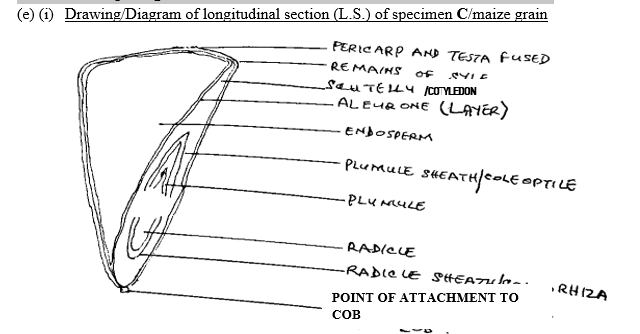LIST OF SPECIMENS
Specimen A – Weevil-damaged bean seed
Specimen B – Viable bean seed
Specimen C – Dried maize grain soaked in water overnight
Specimen D – Soldier termite (dead)
Specimen E – Honeybee (dead)
Specimen F – Muddy water (in a test tube)
Specimen G – Lower jaw of a herbivore with teeth intact
Specimen H – Head of domestic fowl (complete)
Specimen J – Quill feather
Specimen K – Leg of domestic fowl (complete)
Specimen L – Head of duck (complete)
Specimen M – Head of domestic fowl (complete)
- Study specimens A and C and answer questions 1(a) to 1(c).
(a) Classify specimens A and C based on their life cycle. [2marks]
(b) State four observable differences between specimens A and C. [4marks]
(c) State three ways by which the damage to specimen A could have been prevented.
[3marks]
(d) Name the type of germination that would be observed when specimens A and C are planted. [2marks]
(c) Place a flat side of specimen C on the tile. Using the razor blade/scalpel/knife provided cut through the specimen longitudinally.
(i) Make a drawing, 6 cm to 8 cm long of the cut surface of one half of specimen C and label fully. [9marks]
(ii) Add a drop of iodine solution to the cut surface of the other half of specimen C and record the activity on the table below:
Test |
Observation |
Inference |
|
|
|
[5marks]
Many candidates that answered this question performed fairly.
The candidates who performed well in this question were mainly those that correctly identified differences between the bean seed and maize grain and were able to correctly draw and label the maize grain. Most candidates failed to compare the shapes of the specimens. This was a valid criterion that most candidates did not mention.
The candidates that performed well were able to answer the one-word questions and correctly spell the scientific and technical terms such as annual, perennial, epigeal, hypogeal, coleoptile, coleorhiza, although most candidates confused the specimens that undergo the types of germination.
Also, the diagram must be neat, not wooly and not dotted, all guidelines must touch the parts that are labelled, they must be ruled and be horizontal.
Most candidates were unable to observe and report the experiment on food test which made them lose the marks.
The expected answers are:
1. (a) Classification of specimens A and C according to their lifecycle
A: Annual/perennial;
C: Annual.
(b) Observable differences between specimens A and C
A/weevil-damaged bean seed |
C/maize grain |
|
white/yellow/cream coloured; |
|
two scars present; |
|
hilum absent; |
|
absence of hole(s); |
|
shield/oblong shaped; |
|
pericarp/fruit wall present; |
|
presence of two flat sides; |
|
micropyle absent. |
Note: Points must correspond to score.
(c) Ways by which the damage to specimen A could have been prevented
- Storage in air-tight containers/vacuum seal the bean seeds/add oxygen absorber;
- Use of pesticides/fumigant/insecticide;
- Irradiation/radiation of seeds;
- Hygienic storage on sanitation;
- Freezing.
(d) Type of germination of specimens A and C when planted
A: Epigeal;
C: Hypogeal. Note: Spellings must be correct to score.

Title Drawing / Diagram of longitudinal section (L.S.) of
specimen C/maize grain (TL)
Quality (Q)
Clarity of lines (CL)
Size (SZ) (6 cm to 8 cm)
Neatness of labels (NL) All guidelines ruled- ½ mark; All labels horizontal- ½ mark
Magnification (MG) (×6 to ×12)
Details (D)
Cut surface shown in double line (CD)
Endosperm broader than cotyledon (EC)
Labels (L)
Pericarp and testa (fused); endosperm; aleurone layer; scutellum/cotyledon; plumule; radicle; point of attachment to cob; remains of style; plumule sheath (coleoptile); radicle sheath (coleorhiza).
Note: Spellings must be correct to score.
(ii) Table
Test |
Observation |
Inference |
A drop of iodine solution |
Part of the endosperm other parts/cotyledon turn brown |
Presence of starch
Absence of starch |
